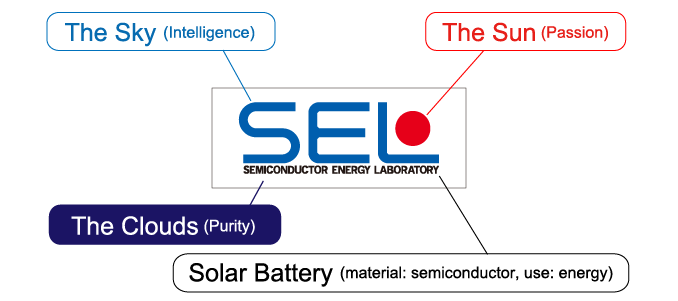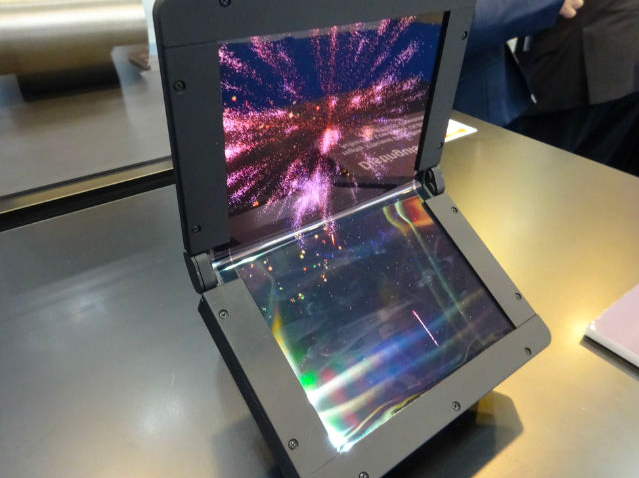New 8K OLED Displays for Tablets and Laptops: 8.3 and 13.3 Inches
by Anton Shilov on December 21, 2018 1:00 PM EST
Semiconductor Energy Laboratory, a technology developer from Japan, has developed the industry’s first 8.3 and 13.3-inch OLED displays featuring an 8K resolution. The monitors use crystalline oxide semiconductor technology and they are likely preliminary designs for future product commercialization. The company also recently showcased a bendable 8.6-inch OLED panel, potentially for a foldable tablet or smartphone.
| Size | Resolution | PPI | Refresh Rate |
Bendy |
| 8.3-inch | 7680 x 4320 | 1062 | 60 Hz | - |
| 13.3-inch | 7680 x 4320 | 663 | 120 Hz | - |
| 8.6-inch | 1900 x 1200 | 263 | 60 Hz | Yes |
Both of SEL’s OLED panels featuring a 7680×4320 resolution use a color filter that relies on CAAC-IGZO (c-axis aligned crystalline indium gallium zinc oxide) material. The 8.3-inch 8K panel can boast with a rather high pixel density of 1061 pixels per inch and has a refresh rate of 60 Hz. The larger 13.3-inch 8K panel features a pixel density of 662 PPI, but has a refresh rate of 120 Hz, which is particularly high for an OLED. The 8.3-inch 8Kp60 OLED was demonstrated last month at SEMICON Japan, whereas the 13.3-inch 8Kp120 OLED currently exists only in SEL’s labs.
The 8.3-inch display is 1062 PPI. For comparison, Sony's Z5 Premium with a 5.5-inch display and 4K resolution was 801 PPI. At 8.3-inches, it's a little big for a smartphone, so it will be interesting if that size can come down a little bit. 8K at 6.5-inches would be 1355 PPI, so the power draw would be quite interesting.
Other notable developments of SEL include a foldable 8.6-inch OLED panel with an 1920×1200 resolution rated for 10,000 bend/unbend cycles (that is 27.4 folds per day over a year) as well as OLED panels capable of displaying the BT.2020 color space.
The primary focus of Semiconductor Energy Laboratory’s work is development of crystalline oxide semiconductor technologies for various applications including chips and displays. CAAC-IGZO is recognized as one of next-generation materials that enable high-resolution low-power displays, so SEL is working on its practical implementations. Being an IP-licensing company, SEL does not have its own production capacities, so it will need a partner to make CAAC-IGZO-based 8K OLEDs a reality.
Related Reading
- Samsung Begins Sales of 65-Inch Q900R 8K UHDTV in the UK
- Samsung Starts to Take Pre-Orders on 85-Inch Q900 8K UHDTV
- Samsung’s One Invisible Connection: 75 Gbps and 230W in a Ultra Thin Cable
- Sharp’s 8K UHD TV Available in Japan, Listed in Europe for €11,899
- Sharp Announces 2nd Gen 8K UHD TVs at IFA
- AUO to Ship 8K UHD TV Panels in Coming Months
- Philips Demos 328P8K: 8K UHD LCD with Webcam, Docking, Coming in 2018
- Dell’s 32-inch 8K UP3218K Display Now For Sale: Check Your Wallet
Source: Optronics Online












59 Comments
View All Comments
Oxford Guy - Friday, December 28, 2018 - link
Caring is irrelevant. What is relevant are the visual limitations of the human eye.Distance totally affects how much resolution is required for "retina" quality. There are no human eyes on the planet that need, for instance, 8K resolution for a television they're standing 30 feet away from. I don't know how close the sharpest-eyed person would need to be for 8K to be relevant in an HDTV usage scenario but tftcentral has posted the equations if you care to find out.
aenews - Monday, December 31, 2018 - link
I hope you realize that there are no tablets with 4K (or any resolution higher than QHD+) at all and neither are there any with higher than 60FPS refresh rate.I definitely want a 4K/120Hz tablet. That's highly useful at the very least. Though I'd want it at around a 10-Inch screen size or somewhat larger. 13.3" might be a bit too large though also worth the compromise.
In addition, of course, with higher and higher resolutions, there will be dwindling returns. However, even if 8K itself is beyond "what is perceptible" (which I'd possibility disagree with depending on distance) it would be perceivably sharper than 4K even on smaller screens.
Vincent33 - Wednesday, December 26, 2018 - link
Reading about 'CAAC-IGZO' on Sharp's site shows the advert 'Outstanding feature -- White OLEDs + RGB color filters'. Still better than LCD for power draw and contrast (full off). If the white OLEDS last better than RGB OLEDs, that is another point.Rec 2020 might be the better feature (75% of visual spectrum), vs DCI P3 (~50%) and Rec 709 (~35%). Like higher resolution, the benefit is if content is uplifted / made for it.
mkozakewich - Wednesday, December 26, 2018 - link
I went to the store, and the smallest 4K screens they had were 43" or so. Even if I'm specifically looking at monitors, I seem to only be able to get 4K at 36" or something. Meanwhile, most phones come with a 5" 1080p at minimum.I would LOVE a 13" 8K display.
Oxford Guy - Friday, December 28, 2018 - link
"I would LOVE a 13" 8K display."I would love 1000 angels dancing upon the head of a pin. It doesn't mean it's going to do anything for me other than part me from cash I could use more wisely for things that truly matter.
aenews - Tuesday, January 22, 2019 - link
I don't think you understood the commenter's point. They're saying that larger displays will benefit from the high PPI that we see already on mobile panels. And the sizes they are quoting are straight from the article (8K @13"). They aren't theoretical.And if you don't see the value, that's fine. It obviously depends on the individual. In any case, these panels are not close to being released. We also don't know any potential costs, so it's difficult to determine how worthwhile they would be in the future.
sharath.naik - Saturday, January 5, 2019 - link
How pointless are these resolutions. the ideal resolution they really should be giving in laptops is 2k 3:2 for all screens 15 inch and up. Even a 4k screen in a laptop is absurd. Advantage of 4k in a laptop.- NONE
Disadvantag
- Battery drain.
- need for discrete graphics for gaming in native resolution.
- lower screen refresh.
I am surprised why there are so few who release 2k screens in laptops lenovo releases it only fot14 inch, and not 15.
aenews - Tuesday, January 22, 2019 - link
Perhaps the costs outweigh the benefits for you. However, that doesn't mean it's unnecessary for others. I definitely would say that QHD is insufficient for 15+ Inch laptops. These are large displays that you generally keep close to your face. Perhaps you keep a large distance between yourself and your laptop? After using QHD+ on mobile devices, not going for a higher resolution on larger displays seems a poor choice for me. It's very clearly less sharp since it's a far larger display. Plain and simple.I'd also note that with any actual 4K (UHD) panel, you can simply run the display at 2K (FHD) as there's even scaling. So there's no disadvantage choosing a 4K panel over a 2K panel especially if the cost difference is minimal.